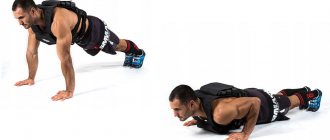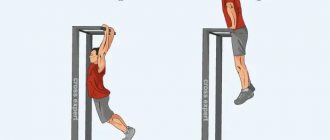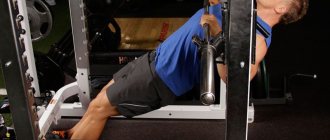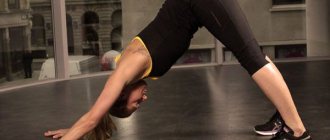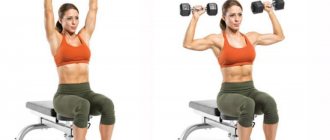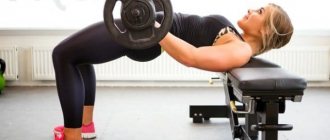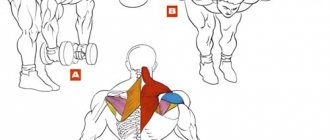Share:
What you need
- Rings
Ring dips are a functional exercise that came to CrossFit from artistic gymnastics. This exercise requires a good level of physical fitness; for most beginners, the technique of performing push-ups on gymnastic rings will seem difficult - it is better to start with parallel bars.
Today we will look at what the fundamental difference between these two exercises is, and also:
- What is the benefit of this exercise;
- Technique for performing ring push-ups;
- CrossFit complexes containing dips.
For what purposes is the exercise suitable?
If you are familiar with different push-up variations, then try ring push-ups instead of, for example, parallel bars.
Push-ups or parallel bars are strength exercises that are performed on a hard, stationary surface. But the option on rings is not only a strength movement, but also a complex coordination movement.
The main feature is the need to constantly monitor the position of the arms and torso in space.
Regular ring push-ups not only develop strength and muscle mass in the upper shoulder girdle, but also improve coordination, flexibility and agility.
The exercise is actively used in the CrossFit training process precisely because of these properties.
What is stagnation?
Athletes who work out in fitness clubs with an abundance of exercise machines and standard equipment and those who work out on horizontal bars and parallel bars in the yards or at home, on the way to achieving heroic shoulders and chests, sooner or later, approximately equally encounter the phenomenon of stagnation . What does this mean?
There comes a time when, using one or another training method and exercise to achieve the shoulders of your dreams, you realize that the growth in results is practically zero, or the progress has stopped altogether. Objectively, this is expressed in the quantitative indicators of the workout: you are “stuck” either on the same weight, for example, in the exercise bench press or dumbbell fly, or on the same number of repetitions – in push-ups or parallel bars. What can you change in your training to achieve your goal?
Execution options
We list the most common ways to perform the movement:
- Horizontal
This is the easiest option with which to begin mastering this projectile.
The rings are lowered down so that the legs rest on the floor and the hands hold on to them. In terms of movement technique, it resembles push-ups from a bench.
Of course, they cannot be considered a full-fledged option, but here they learn to maintain balance and develop coordination, which will be needed in real ring push-ups.
- Vertical push-ups (classic)
The next step is classic push-ups. Here the rings are located at such a height that after going into a full-on position with straight arms, the legs do not touch the floor and are kept suspended. Palms facing each other.
From this starting position, you need to smoothly lower yourself down, bending your elbows. Next, straightening your elbows, return to the starting position.
- Korean
Here the palms are turned forward. Other points remain unchanged. The option is a little more complicated than the classic one.
- Bulgarian
An even more complex movement that involves rotation of the hand during execution (supination-pronation).
Here the starting position is the same as for Korean push-ups. While resting on the rings with straight arms, palms turned forward. When going down, the hands are turned so that the palms are turned back. Rising up, the arms turn forward again.
Gymnastic rings will help you
What spectacular movements are performed by artistic gymnasts on various apparatuses! These athletes are no less impressive in appearance: they have excellent muscles, especially the upper body. And these athletes owe shoulders like those of Greek statues to training, including on gymnastic rings.
This equipment is now gaining popularity in fitness clubs that have so-called functional training areas. But in most ordinary gyms, unfortunately, it is almost impossible to find gymnastic rings. If you have never tried to perform even basic movements on them, for example, to stand upright like a push-up bar, then this gymnastic equipment will surprise you: you will feel a new load that was previously unfamiliar to the muscles of the shoulders, chest and arms.
Your body may wobble and it will be difficult for you to find a stable position. The fact is that gymnastic rings are a very unstable support. Performing any exercises on them creates additional stress on stabilizer muscles that simply did not develop previously. Thus, a “new” type of loading of muscle groups with the help of gymnastic rings will create an impulse for the qualitative development of both smaller stabilizer muscles and muscle groups as a whole.
So, if you have rings in the gym at your disposal, then you can safely start training. It doesn’t matter if you don’t have them: rings can be purchased online and hung on any crossbar in the yard or even at home yourself. Where to start building “epic” shoulder and chest muscles on gymnastic rings?
Who is the exercise suitable for?
Undoubtedly, ring push-ups are not for beginners, or even for people with an average level of physical fitness.
This exercise is a challenge for experienced, well-trained people.
Doing push-ups on the floor several dozen times is a must. Moreover, in several variations - classic, narrow grip, with legs on a hill, and so on.
You also need to master dips, in the range of 20-30 repetitions. To all this add developed abdominal and lower back muscles, as well as a high level of coordination.
Safe training due to adjustable width between rings
For example, the width of the bars is not always 60 cm or more suitable for everyone’s figure, as a result of which during the exercise one feels discomfort in the front delts and even pain. In addition, the elbows may start to “shoot” at the most inopportune moment, which will force you to finish the exercise. According to reviews, standard bars do not suit everyone with their width.
Gymnastic rings solve this problem; in order for the training to be as effective as possible, set the width between them, which will be from your fingertips to your elbow. In addition, it is easy to set the width to be larger to train the chest or smaller to transfer the load to the triceps. In short, the width of the sports equipment will no longer be a problem, which will greatly reduce the risk of injury.
Nuances
Initial lessons contain some nuances, especially for beginners. These exercises involve moving up and down. Beginners are advised to pay attention to the downward movement, as it is easier than lifting the body up. Once you gain some experience and skill, you can switch your attention to the top.
Initial classes can be carried out using a rubber shock absorber. The tourniquet takes part of the beginner’s weight, thereby helping to increase the number of repetitions. Although some prefer natural training. It is also necessary to pay attention to the relative instability of this projectile. Neglecting certain safety rules can lead to injury and muscle tissue rupture.
What can be replaced
If it is impossible to install rings, you can make sports equipment yourself. Two large hemp loops placed on a horizontal bar and handles made of a plastic pipe will allow you to turn a simple device into a gymnastic apparatus and use it instead of parallel bars.
Requirements for performing exercises on rings
Official competitions in artistic gymnastics are held in accordance with the “Rules of the sport “Artistic Gymnastics””, approved by order of the Ministry of Sports of the Russian Federation dated February 13, 2022 N 130.
Classification competitions in artistic gymnastics in the rings discipline must be held on apparatus that meets the requirements of these rules.
The rings are suspended on cables ending with belts 70 cm long and 4 cm wide, the height of the suspension from the floor is 580 cm, the distance between the rings is 50 cm, the height of the rings above the floor is 280 cm, the internal diameter of the ring is 18 cm, the profile diameter is 2.8 cm.
Sports uniform
- On the rings, the athlete must wear gymnastics tights and socks. Gymnastics tights, socks and/or shoes in black or dark shades of blue, green and brown are not permitted.
- The athlete must wear a gymnastics jersey on all apparatus.
- The athlete has a choice between gymnastics shoes and/or socks.
- The athlete must have a number on his uniform issued by the competition organizers.
- The competition uniform must be identical for all members of the same team in qualifying and in the final in team competitions. In qualifying, competitors who do not compete in team competitions may have different competition uniforms.
- Wraps and hand and/or wrist guards are permitted, but must be securely tightened, in good condition, aesthetically pleasing, and not distract from the exercise. It is recommended to use flesh-colored bandages.
Description of the ring exercise
An exercise on rings consists of swing, power and static elements in approximately equal proportions. They are performed through a hang, through or point-blank, through or into a handstand. In this case, execution with straight arms predominates. Modern gymnastics is distinguished by the transition of flywheels into power elements and vice versa. Swinging and crossing of ropes is prohibited.
Exercise information
1. From the main stance, the athlete assumes a hanging position on the rings with or without the help of a belayer. Judging of the exercise begins at the moment when the feet leave the floor. The coach has no right to give an impetus to the athlete's swing.
2. The athlete may include in his exercise only those elements that he can perform safely and with technical and aesthetic skill.
3. The exercise consists of swing, power and static elements in approximately equal proportions. An exercise cannot contain more than 3 elements from group II and/or III, performed in a row.
4. Back swings in support without performing an element, for a simple change of direction or back swings with a transition to a lower hanging position are punishable by a deduction by the judges of panel E. A typical example is: from a hanging bending rise to a kip-up, from a support swing back to a hanging - rise swing forward.
5. Additional technical, aesthetic and performing aspects to the construction of the composition of the exercise:
- the athlete must come to all static positions directly with straight arms without additional body movements;
- duration of static elements - at least 2 seconds;
- forward swing elements must end or pass through a handstand or directly followed by power static elements whenever possible due to the nature of the swing element;
- During all swing elements followed by static elements, the shoulders cannot rise above the level of the final static position. Any deviation will result in appropriate deductions from the E panel judges and, depending on the nature of the element, the element may not be counted by the D panel judges;
- power statics performed after the swing element in the opposite direction (i.e., forward swing lift and “airplane”, forward swing lift and upside down “cross”, etc.) will be considered as a separate element;
- false grip for static power elements is not allowed. A deep grip is performed by gripping the hand in order to gain an advantage when performing power elements, deduction - 0.1 each time;
- Correct grip: straight hand, with or without gripping the fingers around the ring.
- Note: the position of the rings (turned) with a straight and open hand does not change the assessment of a deep grip.
- straight arms should be used in all cases where the nature of the element allows it;
- compositional errors with a deduction of 0.30 points. For example: Honma in support, then corner or leg angle apart, then corner or kip in support and corner;
- Only for power handstands, a minimum touch of the cables with the hands is technically stipulated, and no deduction will be made (elements II.25 and II.26).
6. Yamawaki/Jonason elements with a clear stop or pause receive a deduction of 0.5 for a swing element performed with force (does not count). Such elements with less emphasis will be counted with a small to medium error as a power swing.
7. Some athletes showed very little change in body position after moving from one position to another. Execution errors must be addressed and may also result in failure of the element (i.e., “airplane” to horizontal support, horizontal rear hang to “airplane”).
D rating information
1. There are the following groups of elements:
- I. Kip-ups, flyovers, and flyovers through or into handstand (2 sec.).
- II. power and static elements (2 sec.).
- III. fly elements followed by power static elements (2 sec.).
- IV. dismounts.
2. Repeats of elements (same ID number) cannot be counted by D judges. On the Rings this rule has a slightly broader meaning so that no more than 3 such elements of Groups II and III can be performed in a row. The fourth and subsequent elements from Groups II and/or III will be considered a repetition and will not be scored by the D panel judges. If an athlete decides to perform more elements from Groups II or III, he must perform at least one Group B swing element from Group I ( other than any type of kip-up, kip-back or element with the same number) between the first sequence of a maximum of 3 elements and another element or sequence of group II and/or III. All elements performed from element group II or III belong to this rule, whether they are among the 10 counted or not, even if the element is not counted due to poor technical execution. Such a swing element, a minimum of group B, should be among the 10 best elements.
3. Special repetitions:
- Repeats of elements (same ID number) cannot be counted by the D panel judges. On rings this rule has a slightly broader meaning so that a maximum of 1 power position in each group of elements can be counted for difficulty. For example, only two types of crosses (regular, L-cross, V-cross) or horizontal supports (regular and legs apart) can be performed for difficulty (one element in group II and one in group III).
- A maximum of 2 Gutsogi and a maximum of 2 Li Ning type elements can be performed in an exercise, the 3rd such element will be considered a repeat.
- Basic supports such as corner and v-angle are not included in the special repetition rule, since they are different elements of strength. The gymnast can perform a forward swing into the corner and a forward swing into the V corner. Gymnasts cannot perform more than one final power position in each group of elements. It is impossible to do a kip-up into a corner and a forward swing into a corner in one exercise.
4. Additional rules and regulations:
- all static elements must be held for at least 2 seconds. They will not be considered by the D panel judges as a difficulty and/or as a group requirement unless a stop in the position is shown;
- power push-ups and lifts that are performed after a static element and end in a static element with a stop for 2 seconds are counted only if the previous static part was evaluated and if a stop in the position was shown;
- Elements with cable twisting are prohibited. For such elements a compositional deduction is given;
- for juniors, back somersaults and Li Ning type elements are not allowed;
- Pineda type elements must be performed with a straight body, straight arms and slowly to avoid deductions or being classified as a swing element followed by a power element;
- Yamawaki/Jonason elements with a clear stop or pause are not counted. A standing honma followed by a back swing into a hanging forward flip will not be counted as separate elements due to the athlete's intent to perform the other element. Such elements with less emphasis will be counted with a small to medium error as a power swing;
- a forward somersault into a cross with an entry error of more than 45° will not be counted. The front somersault into a cross cannot be split due to the gymnast's intent to perform another element;
- All static high angle positions (2 sec.) must be performed with legs vertical. Same requirement as floor exercise;
- The exercise should begin from a hang position with straight, vertical arms. The athlete cannot bend his arms when moving to the first position, unless it is provided for by the specifics of the element. Example: The arc and subsequent backswing can begin with the arms bent anywhere in the combination;
- during the exercise, the athlete can bend his arms only when transitioning between elements, when this is necessary to correctly perform the next element;
- for holding items without a cost of 2 seconds. or more deduction - 0.1 each time. Examples include: hold (2 sec) or more, arched hang, bent over hang, back hang;
- Nakayama must pass through a completed horizontal back hang to prevent execution deductions and potential disqualification;
- hanging from behind to lift into a cross or V-cross is not a position that increases the value of the cross (or any other strength element). If such a cross is executed immediately after a back hang, it will be judged according to the Rules (B or C);
- one handstand swing element (2 sec.) is required in the exercise and must be among the 10 best elements (and among the 8 best elements for juniors).
Table of errors and deductions for rings
Brigade D
| Errors | Fine 0.1 | Average 0.3 | Rough 0.5 |
| Lack of flywheel (2 sec.) | + | ||
| More than 2 Gutsogi elements or 2 Li Ning elements | + Not counted by brigade D | ||
Brigade E
| Errors | Fine 0.1 | Average 0.3 | Rough 0.5 |
| Pre-swing at the beginning of the exercise | + | ||
| Push from the coach to create a swing | + | ||
| Moving to a lower position during the backswing | + | ||
| Crossing cables during any element | + | ||
| Hold items without cost for 2 seconds. or more | per element | ||
| Composition errors | + | ||
| Feet apart or other poor execution when pouncing or climbing onto rings | + | ||
| False grip in power static elements (every time) | + | ||
| Bent arms during swing elements followed by power elements or to hold a static position | + | + | + |
| Touching cables or straps with hands, feet or other parts of the body | + | ||
| Support or balance using feet or legs | + don't count | ||
| Falling from a handstand | + don't count | ||
| Excessive rope swing | per element | ||
| The deviation in degrees on the previous force pushing static element also passes to the 2nd element | + | + |
Easily adjustable ring height
Just an example, in my area on the beach there are bars that, at first impression, created more than 2 meters for the guys, they are at my eye level, despite the fact that I myself am not small (1.85 m), which forces me to jump on them with a deep squat . If you have encountered a similar problem, then rings are a great solution. They come with adjustable straps.
If rings are new to you, like ice skates are to Africans, then lower them to waist level and do light push-ups, increasing the height as your muscles and joints strengthen.
They can easily be hung on the horizontal bar; you will forget about the problem of jumping to the horizontal bar or looking for a stand.
